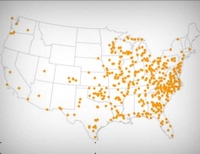by Peter Wagner,
January 31, 2005
The National Voting Rights Institute and the Prison Policy Initiative have filed a brief with the U.S. Court of Appeals for the Second Circuit highlighting the New York State legislature’s racially discriminatory redistricting practice of crediting rural white counties with additional population based on the presence of disenfranchised prisoners in upstate prisons. The Court of Appeals for the Second Circuit is hearing the case of Muntaqim v. Coombe, a case brought by an African-American prisoner alleging that racial disparities in disenfranchisement of prisoners and parolees in New York violate Section 2 of the Voting Rights Act. The friend-of-the-court brief filed by the National Voting Rights Institute and the Prison Policy Initiative argues that the Court should consider the redistricting implications of disenfranchisement as part of the “totality of circumstances” which must be examined under the Voting Rights Act.
Continue reading →
by Peter Wagner,
January 24, 2005
The Importing Constituents: Prisoners and Political Clout in New York report was able to quantify the population loss to New York City from the Census Bureau practice of assigning prisoners residence to the prison location rather than their homes, and the report was able to determine how this benefits up-state prison districts. In 2000, New York City had 43,740 of its residents credited to the communities that contain prisons. As much as 7% of one upstate district’s population is prisoners. Counting prisoners as prison-town residents reduces the number of actual residents in these districts, enhancing the weight of a vote in those prison districts. By extension, this vote enhancement dilutes the votes of residents elsewhere in the state.
We know that compared to the state as a whole, New York City disproportionately sends people to prison, but what about specific neighborhoods in the city? The Importing Constituents report talks of the potential impact on the assumption that prisoners are evenly distributed in the city. Even with that assumption, there was a clear problem in need of a fix. But when the report was written, nobody knew exactly where in the city prisoners came from. The Census Bureau doesn’t collect this information, and the Department of Correctional Services does not publish this information in any more detail than the number of prisoners that come from New York City as a whole. As the Importing Constituents report said, prisoners are very likely concentrated in particular communities. This concentration would mean that specific districts suffer a measurable vote dilution beyond not receiving the same vote enhancement existing in the prison districts.
One recent analysis of prisoner origin in Brooklyn does suggest that prisoners are highly concentrated in origin. As part of a study looking to see where the state spends its criminal justice resources, Eric Cadora used judicial records to map the homes of prisoners from the Brooklyn borough sent to state prison in 2003. He found 35 blocks where more than $1million in state funds were spent to take people out of that community in 2003. Figure 1 is a map of Mr. Cadora’s research as published in the Village Voice. As Cadora used the figure of $30,000 per year to incarcerate someone, each of those 35 blocks would have at least 33 people sent to prison that year. The one “$5 million dollar block” would translate into 167 people that should have been credited by the legislature’s map makers to a single block in Brooklyn. (See Figure 1.) This map isn’t directly translatable to a redistricting analysis, but it does make the very strong case that prisoners are highly concentrated in origin. The clear message is that some communities in Brooklyn lose far more population to prison — and the Census counts of prisoners — than others.
Continue reading →
by Peter Wagner,
January 17, 2005
The Census Bureau counts incarcerated people as if they were residents not of their homes but of the prison’s location. When states like New York ignore their own constitutional requirement that incarceration does not change a residence and use Census data to draw legislative districts, the result is to transfer political power from high incarceration neighborhoods to the areas that contain the prisons.
I’ve previously written about the regional bias implicit in the arrangement. Sixty-six percent of the New York State’s prisoners come from New York City, but 91% of the state’s prison cells are located in the upstate region.
Even more critical is how this impacts the political power of Blacks and Latinos in the state compared to Whites. New York State is 62% White, but 82% of the state’s prison population is Black or Latino.
Virtually all — 98% — of the prison cells are located in state Senate districts that are disproportionately White for the state.
If New York State wants to draw districts that accurately and fairly represent the population of the state, it needs to encourage the Census Bureau to change how it counts prisoners.
Note: The methodology for this article draws its inspiration from Paul Street’s article about Illinois counties: The Color and Geography of Prison [PDF]. This article relies on the new Figure 13 in my 2002 report, Importing Constituents: Prisoners and Political Clout in New York. Consistent with that report and how the New York Legislature and Department of Correctional Services count race and ethnicity, I’ve used the term “White” to mean “Non-Hispanic White” as counted in the U.S. Census. To produce the 98% figure, I calculated from Figure 13 that New York was 62% Non-Hispanic White. I then filtered Figure 13 to show just those legislative districts that were 62% or more Non-Hispanic White, and added up the number of prisoners in each of those districts. The result was 98% of the state prison population in districts that were disproportionately White.
by Peter Wagner,
January 10, 2005
Our recent Importing Constituents: Prisoners and Political Clout in Montana report found one district that was almost 15% prisoners, a higher figure than in any other state legislative district yet discovered in the United States. A little known quirk in the Census counts people in prison as if they were residents of the prison town. This inflates the population of rural prison hosting areas, and shortchanges the areas most prisoners come from.
Prisoners can’t vote in Montana, and on their release they will be returning to their home communities, but their presence at the prison town in the Census dilutes the votes of their family members back home.
Susan Fox, the Legislative Services Division redistricting coordinator in Montana told the Missoula News that the report was “…. fascinating and important… I’ve never had anyone bring this up before.” In an editorial discussing the report, the Great Falls Tribune said how the Census Bureau counts prisoners is “worth re-examining before the 2010 Census-based reapportionment repeats the problem.”
The size and racial distribution of Montana counties are distorted by the Census practice. Almost 19% of Powell County’s population is in the Montana State Prison. Eighty-one percent of the Native American adults counted by the Census in the county are not local voting residents but disenfranchised prisoners from other parts of the state.
Continue reading →
by Peter Wagner,
January 3, 2005
The winner of the New York 35th Senate district race is still undecided two months after the election. Lawyers for both sides are disputing how ballots were handled, as well as which absentee and provisional ballots should be counted in this very close race. Republican incumbent Nicholas A. Spano has a narrow lead in the recount, and he has sought to disqualify many of the uncounted ballots in order to preserve that lead.
Initially challenged were the votes of two homeless women. They testified on December 9 that they had lived at the homeless shelter long enough to make it their residence. Lawyers for both sides agreed with the judge that the women’s votes should be counted.
But 7 prisoners in the Westchester County jail were not so lucky. Lawyers for the incumbent successfully argued that a jail can not be a residence, and so the votes were disqualified. Although convicted felons serving time in prison or on parole cannot vote in New York, people awaiting trial or serving short misdemeanor sentences retain the right to vote. Thus people in jails should generally be allowed to vote. But where?
Continue reading →



